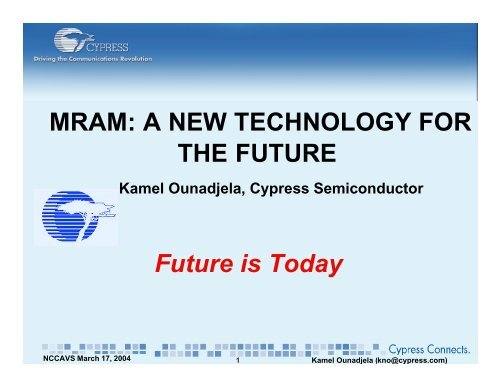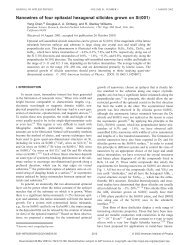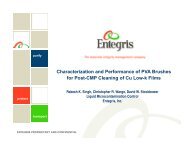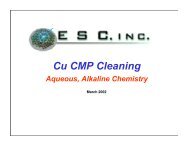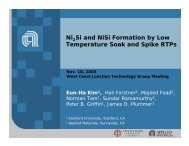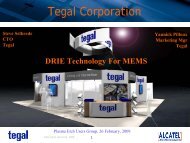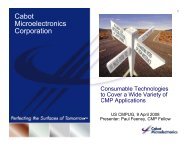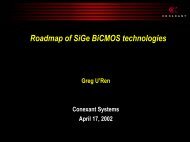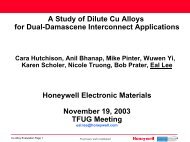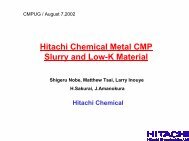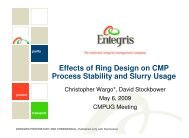MRAM: A New Technology for the Future - NCCAVS - User Groups
MRAM: A New Technology for the Future - NCCAVS - User Groups
MRAM: A New Technology for the Future - NCCAVS - User Groups
Create successful ePaper yourself
Turn your PDF publications into a flip-book with our unique Google optimized e-Paper software.
<strong>MRAM</strong>: A NEW TECHNOLOGY FOR<br />
THE FUTURE<br />
Kamel Ounadjela, Cypress Semiconductor<br />
<strong>Future</strong> is Today<br />
<strong>NCCAVS</strong> March 17, 2004<br />
1<br />
Kamel Ounadjela (kno@cypress.com)
OUTLINE<br />
• WHY <strong>MRAM</strong>?<br />
• ISSUES TO MAKE A WORKING <strong>MRAM</strong><br />
• Read Yield Dependencies:<br />
?MTJs in <strong>MRAM</strong><br />
? IMPORTANCE OF WITHIN-ARRAY MATCHING<br />
? CAN WE DO BETTER?<br />
• Write Yield Dependencies:<br />
? HOW TO INCREASE THE WRITE MARGIN<br />
? THEORY OF ZERO DEFECTS<br />
? ZERO NEEL COUPLING SWITCHING: IMPROVED<br />
LAYER MORPHOLOGY<br />
? ZERO POLES FROM PINNED LAYER: CRITICAL ETCH<br />
STEPS<br />
• Product Pulsing Sequencing<br />
• SCALABILITY<br />
• CONCLUSION<br />
<strong>NCCAVS</strong> March 17, 2004<br />
2<br />
Kamel Ounadjela (kno@cypress.com)
Magnetic Memory: Historical Perspective<br />
Intel 1 Mbits<br />
Magnetic Bubble Memory<br />
1980<br />
CypressSemi, 256kb <strong>MRAM</strong> Chip,<br />
MTJ, 4Mb, 2003<br />
Control Data Corp.<br />
1Kbits Ferrite Core Memory<br />
1965<br />
Honeywell<br />
16Kbits <strong>MRAM</strong> Chip<br />
AMR <strong>Technology</strong> 1994<br />
Motorola 4Mbits <strong>MRAM</strong> Chip,<br />
MTJ, 4Mb, 2003<br />
<strong>NCCAVS</strong> March 17, 2004<br />
3<br />
Kamel Ounadjela (kno@cypress.com)
• <strong>MRAM</strong> Will Become A :<br />
MAINSTREAM MEMORY TECHNOLOGY<br />
• High Per<strong>for</strong>mance NON VOLATILE Storage Element<br />
With FAST READ / WRITE And NO WEAR OUT Will Add<br />
Value To All Areas Of The Semiconductor <strong>Technology</strong><br />
• HOW DO WE KNOW:<br />
WHY <strong>MRAM</strong>?<br />
• Check www.cnn.com about <strong>the</strong> 10 technologies to watch in 2004 in all<br />
areas ranging from medicine, house networking, energy, supply chain,<br />
computer memory, software, wireless broadband … <strong>MRAM</strong> is in <strong>the</strong>re and<br />
is described as:<br />
• Magnetoresistive random acces memory is (in <strong>the</strong>ory, anyway) more than 1,000<br />
times faster than <strong>the</strong> fastest current nonvolatile flash memory and nearly 10<br />
times faster than DRAM. "Nonvolatile" means it retains memory when <strong>the</strong> power<br />
is off. Add in its low power consumption, and it's perfect <strong>for</strong> use in an upcoming<br />
crop of computers and cell phones.<br />
<strong>NCCAVS</strong> March 17, 2004<br />
4<br />
Kamel Ounadjela (kno@cypress.com)
Emerging Memories<br />
• Industry’s Quest - The Search <strong>for</strong> <strong>the</strong> PERFECT Memory:<br />
Low Cost, High Volume, Low Power, NV,<br />
Compatible with Established CMOS Technologies<br />
• Several Non Volatile Technologies in Development: FeRAM, OUM<br />
• <strong>MRAM</strong>s Close to Ideal<br />
Worst<br />
Good<br />
Best<br />
DRAM<br />
SRAM<br />
FLASH<br />
FRAM<br />
<strong>MRAM</strong><br />
OUM<br />
Cost<br />
Access Time<br />
Write Time<br />
Active<br />
power<br />
Stand By<br />
Non Volatile<br />
Endurance<br />
<strong>NCCAVS</strong> March 17, 2004<br />
5<br />
Kamel Ounadjela (kno@cypress.com)
<strong>MRAM</strong> OPPORTUNITIES<br />
<strong>MRAM</strong><br />
1T1R 1T1R (2T/2R)<br />
(2T/2R)<br />
<strong>MRAM</strong><br />
X-Point<br />
Thermal Switching<br />
Spin Spin Transfer<br />
Comparable Speed/Power<br />
Lower Cost<br />
Immunity to Radiation<br />
Non-Volatile<br />
Faster Write/Read<br />
Lower Power<br />
Comparable Cost<br />
Non-Volatile<br />
nondestructive Read<br />
No wear out<br />
In Select Applications<br />
Comparable Cost<br />
Non-Volatile<br />
Comparable Speed<br />
Comparable Cost<br />
Non-Volatile<br />
SRAM<br />
FLASH<br />
DRAM<br />
<strong>NCCAVS</strong> March 17, 2004<br />
6<br />
Kamel Ounadjela (kno@cypress.com)
Cypress Objectives<br />
? Deliver 256K Working <strong>MRAM</strong> Memory<br />
? High Density <strong>MRAM</strong> Memory On Mainstream<br />
SRAM <strong>Technology</strong><br />
? High Density 1.8V and 3V Design <strong>for</strong> Industrial<br />
Applications (cell phones and o<strong>the</strong>rs)<br />
<strong>NCCAVS</strong> March 17, 2004<br />
7<br />
Kamel Ounadjela (kno@cypress.com)
256K <strong>MRAM</strong> PRODUCT DESCRIPTION<br />
CY9C62256<br />
? 5V 256K <strong>MRAM</strong><br />
? Form, Fit & Functionality Compatible with<br />
Micro Power 256K RAM (CY62256)<br />
? Industrial Temperature Range<br />
? Additional <strong>MRAM</strong> Functionality<br />
? Non-Volatile Memory Storage<br />
? Infinite Endurance & Data Retention<br />
? For additional in<strong>for</strong>mation www.siliconmagnetics.com<br />
<strong>NCCAVS</strong> March 17, 2004<br />
8<br />
Kamel Ounadjela (kno@cypress.com)
<strong>MRAM</strong> BASICS (1): THE MTJ<br />
? MTJ Magneto Resistive Effect<br />
• Bottom Pinned Layer Has Electron Spin Fixed In One Direction<br />
• Top Layer Electron Spin Can Be Ei<strong>the</strong>r Parallel or Anti parallel To Pinned<br />
Layer Depending on The Switched State<br />
• When Electron Spins Tunnel Across Tunnel Junction, Tunneling Electrons<br />
See Spin Polarization Dependent of <strong>the</strong> Magnetization Orientation<br />
• This Gives The MR Ratio ? R/R (Example: 3K Ohm/10K Ohm)<br />
Magnetic Tunnel Junction<br />
STORAGE LAYER<br />
INSULATING BARRIER<br />
PARALLEL MOMENTS<br />
LOW RESISTANCE<br />
? R/R=28% @300mV<br />
PINNED LAYER<br />
PARALLEL MOMENTS<br />
LOW RESISTANCE<br />
<strong>NCCAVS</strong> March 17, 2004<br />
9<br />
Kamel Ounadjela (kno@cypress.com)
<strong>MRAM</strong> BASICS (2): Reading And Writing<br />
? Reading: Relies on <strong>the</strong> determination of <strong>the</strong> low or high<br />
resistance state of <strong>the</strong> MTJ<br />
? Writing:<br />
ONLY THE ELEMENT<br />
AT THE INTERSECTION<br />
IS WRITTEN<br />
CURRENT<br />
Y<br />
X<br />
CURRENT<br />
<strong>NCCAVS</strong> March 17, 2004<br />
10<br />
Kamel Ounadjela (kno@cypress.com)
<strong>MRAM</strong> BASICS (3): WRITING DATA<br />
CURRENT<br />
Y<br />
X<br />
CURRENT<br />
CURRENT<br />
SUM OF 2 MAGNETIC FIELDS<br />
ONLY THE ELEMENT<br />
AT THE INTERSECTION<br />
IS WRITTEN<br />
TOP VIEW<br />
Y<br />
X<br />
CURRENT<br />
CURRENT<br />
FIELD GENERATED BY CURRENT<br />
ALONG Y DIRECTION<br />
MAGNETIZATION SWITCH<br />
IN STORAGE LAYER<br />
MAGNETIZATION REMAINS<br />
UNCHANGED IN STORAGE LAYER<br />
<strong>NCCAVS</strong> March 17, 2004<br />
11<br />
Kamel Ounadjela (kno@cypress.com)
Memory Cell: Write And Read Operation<br />
Read Mode<br />
Detection of <strong>the</strong> MR effect:<br />
Read 0: Spins aligned<br />
Read 1: Spins opposing<br />
Write Mode<br />
Write 0: Aligned current pulses in bit and<br />
word lines: Spins aligned<br />
Write 1: Opposed current pulses in bit and<br />
word lines: Spins opposing<br />
<strong>NCCAVS</strong> March 17, 2004<br />
12<br />
Kamel Ounadjela (kno@cypress.com)
STANDARD <strong>MRAM</strong> PROCESS<br />
PERIPHERY<br />
<strong>MRAM</strong> CELL<br />
MAGNETIC STACK<br />
Bit Line<br />
Digit Line<br />
M2<br />
M1<br />
=<br />
ST CMOS<br />
Process<br />
ADDS ON TO STANDARD LOGIC<br />
AND/OR MEMORY PROCESS<br />
<strong>NCCAVS</strong> March 17, 2004<br />
13<br />
Kamel Ounadjela (kno@cypress.com)
<strong>MRAM</strong> PROCESS And INTEGRATION<br />
M3: BIT LINE<br />
M2:<br />
DIGIT LINE<br />
M1<br />
<strong>NCCAVS</strong> March 17, 2004<br />
14<br />
Kamel Ounadjela (kno@cypress.com)
IMPORTANCE OF WITHIN-ARRAY<br />
MATCHING<br />
• BASIC FEASIBILITY PROVEN – SINGLE <strong>MRAM</strong> BIT IS WORKING<br />
(THIS IS NOT A TRIVIAL STATEMENT…)<br />
• CHALLENGE FOR A VIABLE <strong>MRAM</strong> PRODUCT:<br />
MAKING ALL BITS IN A DIE SUFFICIENTLY IDENTICAL<br />
? CELL & BIT DESIGN FOR OPTIMUM MARGIN<br />
? IMPROVED MTJ MATERIALS<br />
? PROCESS INTEGRATION<br />
FREQUENCY<br />
DESIRED WITHIN-ARRAY DISTRIBUTIONS<br />
?H c /H c = MIN<br />
FOR WRITE WINDOW<br />
H c<br />
?H c<br />
BIT SWITCHING CURRENT<br />
FREQUENCY<br />
?R MIN /R MIN = MIN<br />
FOR READ WINDOW<br />
R MIN<br />
?R MIN<br />
BIT RESISTANCE<br />
<strong>NCCAVS</strong> March 17, 2004<br />
15<br />
Kamel Ounadjela (kno@cypress.com)
READ YIELD: MTJ STACK<br />
12<br />
SCHEMATIC LAYER<br />
STRUCTURE<br />
- TOP ELECTRODE<br />
- FERROMAGNET<br />
TYPICAL X-WFR DATA (8”)<br />
@ 300 mV<br />
MR RATIO<br />
RESISTANCE<br />
[%] [k? ]<br />
AlOx<br />
Ru<br />
- FERROMAGNET<br />
- FERROMAGNET<br />
- ANTI-<br />
FERROMAGNET<br />
- BOTTOM<br />
ELECTRODE<br />
27.3 26.4 27.4 26.6 27.6 26.7<br />
27.6 25.8 26.2 26.3 25.9 26.4 26.7 27.2<br />
27.1 26.4 25.5 26.0 25.6 25.7 25.4 26.9<br />
26.8 25.9 26.5 26.2 25.5 26.1 26.8 26.6<br />
26.7 25.8 26.2 26.5 26.4 26.0 26.4 26.9<br />
26.9 26.7 25.6 26.5 25.9 26.5<br />
10.5 10.1 10.5 10.8 10.4 9.9<br />
10.8 10.4 10.9 10.3 10.7 10.9 10.8 10.5<br />
10.6 11.0 10.4 10.8 11.0 10.3 11.0 10.9<br />
11.3 10.5 10.9 10.7 10.7 10.3 11.5 10.9<br />
11.1 11.3 10.9 10.9 10.8 11.2 11.3 11.4<br />
11.5 11.0 11.2 11.0 11.4 12.1<br />
MEAN: 26.4<br />
STDEV: 2.2%<br />
MEAN: 10.9<br />
STDEV: 3.9%<br />
• RA ~3 k? -?m 2 , MR @ 300 mV ~25-40% (MATERIAL DEPENDENT)<br />
<strong>NCCAVS</strong> March 17, 2004<br />
16<br />
Kamel Ounadjela (kno@cypress.com)
READ YIELD: HOMOGENEITY OF TUNNEL BARRIER<br />
• MTJ BARRIER INTEGRITY IS CRITICAL FOR WIDE SEPARATION<br />
OF WITHIN-ARRAY RESISTANCE DISTRIBUTIONS<br />
TUNNELING CURRENT [a. u.]<br />
Bit #1 Bit #2<br />
“Hot Spots”<br />
Bit #1 Bit #2<br />
Position On Wafer<br />
Bit #1<br />
Bit #2<br />
Bit #1<br />
Bit #2<br />
WITHIN-ARRAY DISTRIB.<br />
Rp<br />
NO<br />
WINDOW<br />
WIDE<br />
WINDOW<br />
Rap<br />
• DIFFERENCES MAY NOT BE SIGNIFICANT AT THE SINGLE<br />
BIT PERFORMANCE LEVEL (MR, RA), BUT…<br />
<strong>NCCAVS</strong> March 17, 2004<br />
17<br />
Kamel Ounadjela (kno@cypress.com)
HOMOGENEITY OF TUNNEL BARRIER<br />
• …IN LARGE BIT POPULATIONS, IMPROVED BARRIER SHOWS<br />
REDUCED BIT-TO-BIT VARIABILITY<br />
Cumulative Probability<br />
0.99<br />
0.9<br />
0.7<br />
0.5<br />
0.3<br />
0.1<br />
0.01<br />
AlOx Tunnel Barrier:<br />
Barrier #1 - BASELINE<br />
Barrier #2<br />
TUNNEL BARRIERS<br />
Barrier #3<br />
Barrier #4 WITH IMPROVED<br />
Barrier #5 HOMOGENEITY<br />
-500 -300 -100 100 300 500 700<br />
Resistance Difference Between Neighbouring Bits [? ]<br />
CUMULATIVE PROBABILITY PLOTS OF RESISTANCE DIFFERENCE BETWEEN NEIGHBOURING<br />
BITS SAMPLED FROM THE ARRAYS OF MTJs WITH ALOx BARRIER PREPARED IN VARIOUS WAYS<br />
<strong>NCCAVS</strong> March 17, 2004<br />
18<br />
Kamel Ounadjela (kno@cypress.com)
HOMOGENEITY OF TUNNEL BARRIER<br />
• WITH MTJs OF IMPROVED MICROSTRUCTURE, A TIGHT CONTROL<br />
OF WITHIN-ARRAY BIT RESISTANCE CAN BE ACHIEVED<br />
Cumulative Probability<br />
0.99<br />
0.9<br />
0.7<br />
0.5<br />
0.3<br />
0.1<br />
0.01<br />
Frequency<br />
30000<br />
20000<br />
10000<br />
0<br />
524,288 MTJs<br />
1? = 1.1%<br />
ZERO OUTLIERS<br />
10.0<br />
10.3<br />
10.6<br />
10.9<br />
11.2<br />
11.5<br />
11.8<br />
MTJ Resistance [k? ]<br />
10.5<br />
10.8<br />
11.1<br />
11.5<br />
11.8<br />
MTJ Resistance [k? ]<br />
? MTJ RESISTANCE VARIATION WITHIN A FULLY INTEGRATED<br />
256K DIE: NORMAL DISTRIBUTION (1.1%), NO OUTLIERS<br />
<strong>NCCAVS</strong> March 17, 2004<br />
19<br />
Kamel Ounadjela (kno@cypress.com)
HOMOGENEITY OF TUNNEL BARRIER<br />
• “LOW” AND “HIGH” RESISTIVITY DISTRIBUTIONS WITHIN A<br />
256K <strong>MRAM</strong> DIE SHOW A DISTINCT SEPARATION (>23? )<br />
? R = 2.99 k? = 23.9 ?<br />
75000<br />
R P ????125 ??(1.1%)<br />
50000<br />
Count<br />
25000<br />
R P<br />
Resistance (? )<br />
R AP<br />
10400 11200 12000 12800 13600 14400<br />
<strong>NCCAVS</strong> March 17, 2004<br />
20<br />
Kamel Ounadjela (kno@cypress.com)
13<br />
? The Half Select Problem:<br />
? Switching Distribution is a killer => Needs to be<br />
tighten to increase writing Margin<br />
Y<br />
CURRENT<br />
Unselected<br />
Bits Switch<br />
X<br />
CURRENT<br />
Selected Bits<br />
Don’t Switch<br />
Unselected<br />
Bits Switch<br />
<strong>NCCAVS</strong> March 17, 2004<br />
21<br />
Kamel Ounadjela (kno@cypress.com)
IDEAL WRITE/DISTURB WINDOW<br />
WRITING DIST<br />
WRITE WINDOW<br />
DIGIT LINE CURRENT = 6MA<br />
WRITE/DISTURB<br />
WINDOW<br />
DISTURB WINDOW<br />
DIGIT LINE CURRENT = 0MA<br />
1 2 3 4 5 6 7 8 9 10 11 12 13 14 15 16<br />
I BIT (MA)<br />
WRITING DIST<br />
WRITE WINDOW<br />
BIT LINE CURRENT = 6MA<br />
WRITE/DISTURB<br />
WINDOW<br />
DISTURB WINDOW<br />
BIT LINE CURRENT = 0MA<br />
1 2 3 4 5 6 7 8 9 10 11 12 13 14 15 16<br />
I DIGIT (MA)<br />
<strong>NCCAVS</strong> March 17, 2004<br />
22<br />
Kamel Ounadjela (kno@cypress.com)
WRITE/DISTURB DISTRIBUTIONS:<br />
What are <strong>the</strong> problems<br />
PROBLEM#1<br />
BIT MATCHING<br />
VARIABILITY<br />
WRITING DIST<br />
WRITE WINDOW<br />
DIGIT LINE CURRENT = 6MA<br />
WRITE/DISTURB<br />
WINDOW<br />
DISTURB WINDOW<br />
DIGIT LINE CURRENT = 0MA<br />
1 2 3 4 5 6 7 8 9 10 11 12 13 14 15 16<br />
I BIT (MA)<br />
Define <strong>New</strong><br />
Scheme <strong>for</strong><br />
Dot Shape<br />
PROBLEM#2<br />
INTERLAYER<br />
COUPLING<br />
SHIFT<br />
WRITING DIST<br />
WRITE WINDOW<br />
BIT LINE CURRENT = 6MA<br />
NO<br />
WINDOW<br />
DISTURB WINDOW<br />
BIT LINE CURRENT = 0MA<br />
Improve<br />
Integration<br />
1 2 3 4 5 6 7 8 9 10 11 12 13 14 15 16<br />
I DIGIT (MA)<br />
<strong>NCCAVS</strong> March 17, 2004<br />
23<br />
Kamel Ounadjela (kno@cypress.com)
SORT TEST FOR BL & DL DISTURB<br />
16<br />
10 1<br />
0<br />
1 0<br />
1<br />
COMPARE<br />
1? ?<br />
?<br />
1<br />
0<br />
1<br />
0<br />
1<br />
0<br />
?<br />
?<br />
?<br />
0<br />
1<br />
0<br />
1<br />
0<br />
1<br />
?<br />
?<br />
?<br />
Writing Checkerboard<br />
Writing Inverse checkerboard<br />
Bit counts = 9<br />
10 1<br />
0<br />
1 1<br />
1<br />
1? ?<br />
?<br />
1<br />
1<br />
1<br />
0<br />
1<br />
0<br />
?<br />
?<br />
?<br />
0<br />
0<br />
1<br />
1<br />
0<br />
1<br />
?<br />
?<br />
?<br />
Writing Checkerboard<br />
Writing Inverse checkerboard<br />
Bit counts = 5<br />
• Allow to check multiple disturbs and select on each site<br />
• Output is range of current at which select/Disturb is best<br />
<strong>NCCAVS</strong> March 17, 2004<br />
24<br />
Kamel Ounadjela (kno@cypress.com)
1 DIE SORT YIELD W/ BL & DL DISTURB<br />
17<br />
? Cy shape:<br />
Uses <strong>the</strong> S state <strong>for</strong> <strong>the</strong> writing and <strong>the</strong> C state<br />
<strong>for</strong> <strong>the</strong> disturb.<br />
?Good operating window<br />
? Shape designed to have <strong>the</strong> C state stable at rest<br />
<strong>for</strong> improving <strong>the</strong> Bit Line Disturb (Vortex <strong>for</strong>mation).<br />
? Needs <strong>the</strong> Digit Line current to reach <strong>the</strong> S state<br />
<strong>NCCAVS</strong> March 17, 2004<br />
25<br />
Kamel Ounadjela (kno@cypress.com)
Improved Shape: Uses C and S states 18<br />
Magnetic states very close in energy. Small perturbations (defects <strong>for</strong> instance) may<br />
<strong>for</strong>ce to stabilize in one states at <strong>the</strong> expense of <strong>the</strong> o<strong>the</strong>r.<br />
C state<br />
S state<br />
Vortex <strong>for</strong>mation<br />
and annihilation.<br />
High cost in<br />
energy. High<br />
switching field.<br />
Coherent<br />
rotation. Low<br />
cost in energy.<br />
Low switching<br />
field.<br />
Relaxed state: No field applied<br />
Transverse Field applied<br />
<strong>NCCAVS</strong> March 17, 2004<br />
26<br />
Kamel Ounadjela (kno@cypress.com)
19<br />
How reversal occurs when starting from C states…<br />
Vortex<br />
<strong>for</strong>mation<br />
Relaxed state<br />
No current<br />
Be<strong>for</strong>e<br />
reversal<br />
After<br />
reversal<br />
Transverse<br />
field<br />
I DL<br />
=10Oe<br />
I BL<br />
= 0 mA<br />
Transverse<br />
field just<br />
be<strong>for</strong>e<br />
reversal<br />
Transverse<br />
field just<br />
after<br />
reversal<br />
<strong>NCCAVS</strong> March 17, 2004<br />
27<br />
Kamel Ounadjela (kno@cypress.com)
Select and Disturb Behavior<br />
Improved Free Layer+Integration<br />
22<br />
80<br />
60<br />
40<br />
20<br />
Count Axis<br />
80<br />
60<br />
40<br />
20<br />
Count Axis<br />
0 4 8 12 18 24 30 36 42 48 54 60 66<br />
0 4 8 12 18 24 30 36 42 48 54 60 66<br />
150<br />
100<br />
50<br />
Count<br />
125<br />
100<br />
75<br />
50<br />
25<br />
Count<br />
0 4 8 12 18 24 30 36 42 48 54 60 66<br />
22Oe Window X-wafer<br />
0 4 8 12 18 24 30 36 42 48 54 60 66<br />
No Window X-wafer<br />
<strong>NCCAVS</strong> March 17, 2004<br />
28<br />
Kamel Ounadjela (kno@cypress.com)
Switching Distribution<br />
25<br />
1.0<br />
0.9<br />
0.8<br />
Cumulative Probability<br />
0.7<br />
0.6<br />
0.5<br />
0.4<br />
0.3<br />
0.2<br />
0.1<br />
Hc1<br />
Hc2<br />
Hc1<br />
Hc2<br />
Hc1<br />
Hc2<br />
Median Std Dev<br />
14.25 5.45<br />
13.06 3.82<br />
14.38 2.00<br />
12.77 1.98<br />
12.84 1.52<br />
10.45 1.50<br />
QF For Switching<br />
2.6<br />
3.41<br />
7.19 Hc1<br />
6.44<br />
8.48<br />
6.96<br />
Hc2<br />
0.0<br />
0 10 20 30 40<br />
Switching Field (Oe)<br />
• What could be <strong>the</strong> Factors of Improvement<br />
• Optimizing Dot Shape<br />
• Reducing Interlayer coupling by Optimizing Integration (Etch + Material<br />
Stack<br />
<strong>NCCAVS</strong> March 17, 2004<br />
29<br />
Kamel Ounadjela (kno@cypress.com)
X- Wf Interlayer Coupling vs Disturbed Bits In Dies<br />
23<br />
Interlayer Coupling (Oe)<br />
2<br />
0<br />
-2<br />
-4<br />
-6<br />
Interlayer Coupling<br />
0 10000 20000 30000 40000 50000<br />
Median Disturbed Bits<br />
? Larger <strong>the</strong> interlayer coupling, larger is <strong>the</strong> median Disturbed Bits<br />
? Having an Interlayer Coupling close to Zero is not good enough<br />
<strong>NCCAVS</strong> March 17, 2004<br />
30<br />
Kamel Ounadjela (kno@cypress.com)
Simple Picture <strong>for</strong> Interlayer Coupling<br />
27<br />
Resistance (kOhms)<br />
13<br />
12<br />
11<br />
10<br />
No Interlayer Coupling<br />
Resistance (kOhms)<br />
-10 -5 0 5 10<br />
13<br />
12<br />
11<br />
10<br />
Positive Interlayer<br />
Coupling: Neel Coupling<br />
Favor <strong>the</strong> parallel State<br />
Resistance (kOhms)<br />
-10 -5 0 5 10<br />
13<br />
12<br />
11<br />
10<br />
-10 -5 0 5 10<br />
Bit line current (mA)<br />
Negative Interlayer<br />
Coupling: Poles due to<br />
Pinned Layer<br />
Favor Antiparallel State<br />
<strong>NCCAVS</strong> March 17, 2004<br />
31<br />
Kamel Ounadjela (kno@cypress.com)
BIT SWITCHING BALANCING SCHEMES<br />
• BALANCED BIT HYSTERESIS LOOP IS DESIRED FOR<br />
SYMMETRICAL AND STABLE BIT SWITCHING<br />
(a)<br />
TYPICAL<br />
Neel +5 Oe<br />
ZERO OFFSET LOOP<br />
FOR SYMMETRICAL<br />
BIT SWITCHING<br />
ALTERNATIVE<br />
Neel ~0 Oe<br />
(b)<br />
Poles -5 Oe<br />
Poles ~0 Oe<br />
Free<br />
AlOx<br />
Pinned Layer<br />
Free<br />
AlOx<br />
Pinned Layer<br />
• THE TWO BALANCING SCHEMES ARE ALMOST IDENTICAL<br />
AT THE SINGLE BIT SWITCHING LEVEL, BUT…<br />
<strong>NCCAVS</strong> March 17, 2004<br />
32<br />
Kamel Ounadjela (kno@cypress.com)
Origin of interlayer coupling (1)<br />
28<br />
• Orange Peel coupling (Neel type)<br />
• Originates from roughness during deposition of magnetic films.<br />
• Interlayer coupling is negative (Favors Parallel state)<br />
• Uni<strong>for</strong>mity dictated by <strong>the</strong> roughness height and wave length.<br />
Today,we are able to achieve a Neel Coupling close to 1Oe by<br />
making extremely smooth and uni<strong>for</strong>m stacks.<br />
t F<br />
t S<br />
h<br />
2 2<br />
? ? h ?<br />
H ?<br />
Ms exp<br />
2?<br />
2 tS<br />
/ ? ?<br />
2<br />
?<br />
? t<br />
? F ?<br />
? T<br />
<strong>NCCAVS</strong> March 17, 2004<br />
33<br />
Kamel Ounadjela (kno@cypress.com)
BIT SWITCHING BALANCING SCHEMES<br />
• …IN LARGE BIT POPULATIONS, ZERO NEEL COUPLING<br />
ALLOWS FOR NARROWER BIT SWITCHING DISTRIBUTION<br />
0.99<br />
Cumulative Probability<br />
0.9<br />
0.7<br />
0.5<br />
0.3<br />
0.1<br />
0.01<br />
Bit Switching Loop Centering Scheme:<br />
Neel ~0 Oe, Poles ~0 Oe (b)<br />
Neel+Poles ~0 Oe (a)<br />
MTJ Switching Field [a.u.]<br />
CUMULATIVE PROBABILITY PLOTS OF BIT SWITCHING DISTRIBUTIONS SAMPLED FROM<br />
THE ARRAYS OF MTJs PATTERNED USING DIFFERENT LOOP CENTERING SCHEMES<br />
? BETTER CONTROL OF BIT-TO-BIT VARIABILITY<br />
<strong>NCCAVS</strong> March 17, 2004<br />
34<br />
Kamel Ounadjela (kno@cypress.com)
1 2 3 4 5<br />
NEAR-ZERO NEEL COUPLING<br />
• LOW NEEL COUPLING POSSIBLE WITH NANOCRYSTALLINE<br />
AND SMOOTHER MTJ LAYERS<br />
Neel Coupling<br />
Field [Oe]<br />
6<br />
5<br />
4<br />
3<br />
2<br />
1<br />
0<br />
MTJ#1 - BASELINE<br />
MTJ#2<br />
MTJ#3<br />
MTJ#4<br />
MTJ#5<br />
NANOCRYSTALLINE<br />
(OR AMORPHOUS)<br />
AND SMOOTHENED<br />
LAYERS<br />
AlOx<br />
AlOx<br />
AlOx<br />
PtMn PtMn PtMn<br />
CONTRARY TO CIP DEVICES<br />
(SPIN VALVES), MTJs DO NOT FACE<br />
LIMITATIONS IN USING MORE<br />
HOMOGENEOUS, BUT OF HIGHER<br />
RESISTIVITY, NANOCRYSTALLINE<br />
OR AMORPHOUS MATERIALS<br />
? LOW NEEL COUPLING CORRELATES WITH MORE<br />
HOMOGENEOUS MTJs (TEM CROSSECTIONS)<br />
<strong>NCCAVS</strong> March 17, 2004<br />
35<br />
Kamel Ounadjela (kno@cypress.com)
SCALABILITY<br />
38<br />
? <strong>Technology</strong> Elements:<br />
? 100nm <strong>Technology</strong> Node: Cell Size Below 0.2 ?m2<br />
? TJ Size Metal Limited<br />
? Magnetic cladding on top of Metal Line to Boost <strong>the</strong><br />
magnetic field provided by <strong>the</strong> current<br />
? Scaling Challenges<br />
? Reaching <strong>the</strong> Superparamagnetic limit (Making <strong>the</strong> dot<br />
smaller)<br />
<strong>NCCAVS</strong> March 17, 2004<br />
1. Data Retention and Error Rate. Needs new scheme to go<br />
beyond this limit<br />
? Switching<br />
1. Increased switching current: Need Magnetic Liners To Boost<br />
Magnetic Field (4X) with <strong>the</strong> same current<br />
2. Patterning Control<br />
? Junction Resistance<br />
1. Need extra control on RA product and higher MR ratio: Need<br />
<strong>New</strong> Magnetic Stack and Better Etch control<br />
36<br />
Kamel Ounadjela (kno@cypress.com)
38<br />
SUMMARY<br />
? Most of <strong>the</strong> issues to make a manufacturable <strong>MRAM</strong> Part have<br />
been resolved: Working parts have been demonstrated. Still<br />
Some problems subsist such as Yield Increase (Compared to<br />
SC <strong>Technology</strong>)<br />
? 3 Vectors of Optimization<br />
? Dot Shape optimization:<br />
? Stack and Integration optimization:<br />
? Materials and thickness<br />
? Interlayer Coupling: Critical issues are Control of Poles Thru<br />
? Pinned layer: Avoid any poles to affect switching of <strong>the</strong><br />
free layer<br />
? Smoothness, Smoothness and Smoothness again<br />
? Limit Thermal Degradation<br />
? Programming Conditions<br />
? Pulse width<br />
? Time delay between DL and BL pulses found critical to have a<br />
sharp transition between write and no write<br />
<strong>NCCAVS</strong> March 17, 2004<br />
37<br />
Kamel Ounadjela (kno@cypress.com)
39<br />
Acknowledgements:<br />
Witek Kula<br />
Fred Jenne<br />
Bettye Wadkins<br />
Hualiang Yu<br />
Bill Koutny<br />
Helen Chung<br />
Sam Geha<br />
Eugene Chen<br />
Biju Parameshwaran<br />
Mehran Sedigh<br />
Ben Schwarz<br />
Chang Ju Choi<br />
June Sananikone<br />
Jeff Kaszubinski<br />
<strong>NCCAVS</strong> March 17, 2004<br />
38<br />
Kamel Ounadjela (kno@cypress.com)


